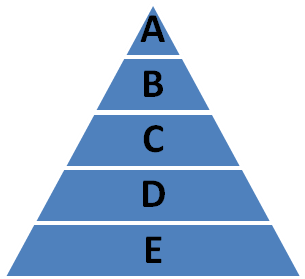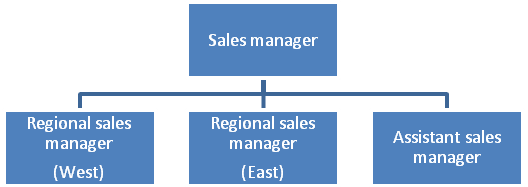
Types of managers
We have been using the term manager to mean anyone who is responsible for carrying out the four main activities of management in relationships over time. One way to grasp the complexity of management is to see that managers can practice at different levels in an organization and with different ranges of organizational activities. After looking at the level and scope of various kinds of managers, we will go on to see how different skills and roles are emphasized in different types of management.
Management Levels
First-line managers. The lowest level in an organization at which individuals are responsible for the work of others is called first-line or first-level management. First-line managers direct non-management employees; they do not supervise other managers. Examples of first-line managers are the foreman or production supervisor in a research department, and the clerical supervisor in a large office. First-level managers are often called "supervisors". A school principal is also a first-level manager, as is the manager of a major league baseball team.
Middle managers. The term middle management can include more than one level in an organization. Middle managers direct the activities of lower-level managers and sometimes those of operating employees as well. Middle managers' principal responsibilities are to direct the activities that implement their organizations' policies and to balance the demands of their managers with the capacities of their employers.
Top managers. Composed of a comparatively small group of people, top management is responsible for the overall management of an organization. These people are called executives. They establish operating policies and guide the organization's interactions with its environment. Typical titles of top managers are "chief executive officer", "president", and "vice president."
Functional and General Managers
Another major classification of managers depends on the scope of activities they manage. Organizations are often described as a set of functions. A function, in this sense, is a collection of similar activities. The marketing function, for example, commonly consists of sales, promotion, distribution, and market research activities. At Coca Cola, the marketing function is responsible for TV ads, and the research and development function is responsible for Coke's special formula. On college campuses, the athletic department is a function, because the activities of its members differ from what, say, the members of the philosophy department do.
Functional managers. The functional manager is responsible for only one functional area, such as production, marketing, or finance.
General managers. The general manager, on the other hand, oversees a complex unit, such as a company, a subsidiary, or an independent operating division. He or she is responsible for all the activities of that unit, such as its production, marketing, and finance. A small company may have only one general manager - its president or executive vice president - but a large organization may have several, each heading a relatively independent division. In a large food company, for example, there may be a grocery-products division, a refrigerated-products division, and a frozen food-products division, with a different general manager responsible for each.
It is important to remember that functional and general managers alike plan, organize, lead, and control relationships over time. The difference, again, is in the scope of activities that they oversee.
Management Level and Skills
Robert L. Katz, a teacher and business executive, has popularised a concept developed early in this century by Henry Fayol, a famous management theorist. Fayol identified three basic kinds of skills: technical, human, and conceptual (see Theory 1). Every manager needs all three.
Fayol and Katz suggest that although all three of these skills are essential to a manager, their relative importance depends mainly on the manager's rank in the organization. Technical skill is most important in the lower levels. Human skill, although important for managers at every level, is the primary skill needed by middle managers; their ability to tap the technical skills of their subordinates is more important than their own technical proficiency. Finally, the importance of conceptual skill increases as one rises through the ranks of a management system. At higher and higher organizational levels, the full range of relationships, and the organization's place in time, are important to understand. This is where a manager must have a clear grasp of the big picture.
Who is a manager?
What do first-line managers do?
What do middle managers do?
What do top managers do?
What is a function? What are the main functions in an organization?
Who are functional managers?
Who are general managers?
What is the most important skill for first-line managers?
What is the most important skill for middle managers?
What is the most important skill for top managers?
SUMMARY-2 POINT
►Translate the phrases below into Russian and make them stick in your mind. Use as many of them as possible to summarize Theory 2:
first-line managers/ line managers/ junior managers
to direct non-management employees
middle managers
to direct the activities of lower-level managers
to implement the organizations’ policies
top managers/ senior managers
to be responsible for the overall management of an organization
to guide the organization’s interactions with its environment
chief executive officer
the scope of activities
functional managers
general managers
to oversee a complex unit
a subsidiary
to tap technical skills of subordinates
human skill
conceptual skill
to rise through the ranks of a management system
PUZZLE-3 POINT
Complete the text using the correct form of these verbs:
achieve allocate balance deal with develop
employ establish follow require set
The top managers of a company (1) have to ………………. objectives and then develop particular strategies that will enable the company to (2) them. This will involve (3) the company's human, capital and physical resources. Strategies can often be sub-divided into tactics - the precise methods in which the resources attached to a strategy are (4)……………
The founders of a business usually establish a "mission statement" - a declaration about what the business is and what it will be in the future. The business’s central values and objectives will (5)…………………from this. But because the business environment is always changing, companies will occasionally have to modify or change their objectives. It is part of top management's role to (6)……………… today's objectives and needs against those of the future, and to take responsibility for innovation, without which any organisation can only expect a limited life. Top managers are also expected to set standards, and to (7)………………… human resources, especially future top managers.
They also have to manage a business's social responsibilities and its impact on the environment. They have to (8)……………….. and maintain good relations with customers, major suppliers, bankers, government agencies, and so on. The top management, of course, is also on permanent stand-by to (9)…………………. major crises.
Between them, these tasks (10) many different skills which are almost never found in one person, so top management is work for a team. A team, of course, is not the same as a committee: it needs a clear leader, in this case the chairman or managing director.
Complete the following collocations:
to set
to allocate
to responsibility
to standards
to and good relations
to a crisis
CHECK POINT
What are the challenges that managers face in today's competitive world?
Describe each of the major functions of management: planning, organizing, leading, and controlling.
What is the nature of work agenda and its three main factors?
What roles do managers act out at various times?
Explain why a knowledge base and the key management skills are important to managers.
Describe and compare three management levels.
What is the difference between functional and general managers?
( Revised
Unit 3 from Business & English by Levon Gzokyan)
Revised
Unit 3 from Business & English by Levon Gzokyan)
‘WARM-UP’ POINT
►Traditionally, business organizations have been given hierarchical (pyramidal) structures. Look at the pyramid below which reflects this sort of structure, do the assignment and answer the question:
Describe each layer of the pyramid and the lines or levels of authority involved, i.e. who reports to whom.
Is this structure centralized or decentralized? Why?

A – MD (Managing Director)
B – Senior managers
C – Middle managers
D – Junior managers
E – Operatives and support staff


‘TRANSLATION-1’ POINT
►Translate into Russian:
(1) Whatever their structure, large companies, in order to manage their growing complexities, tend to become hierarchical. A hierarchy essentially differentiates people in terms of power in a vertical fashion. Those at the top are the chief decision-makers in the organization, whereas those at the bottom, who carry out the routine activities of the business, have little decision-making power. There may be many layers of management and supervision in between. Each worker in the hierarchy has a definite position, with lines of authority above and below, in a system known as bureaucracy. When we think of bureaucracies, we think of the benefits of efficiency, with each task fitting into an overall whole, as in an assembly line. But we also tend to think of bureaucracies as inflexible and dependent on procedural formalities. They function best in unchanging environments, but in the context of a rapidly changing competitive environment, companies are shifting away from the bureaucratic model in order to introduce more flexibility, more open communication and quicker responses to customer needs.
(2) One of the obvious reforms of bureaucratic structures is to reduce the number of layers, or flatten the structure. The structure may be flattened by reducing layers in the middle if there are too many layers of middle management. Or the power to take decisions may be decentralized to lower levels, through empowerment, one of the major developments in HRM thinking. Empowerment holds that employees at all levels in the organization are responsible for their own actions, and should be given authority to make decisions about their work. The rationale behind empowerment is that those at the lower levels have considerable knowledge of operational matters and are able to respond more quickly.
‘PROS & CONS-1’ POINT
►Fill in the table with the information you have come up with and learned so far:
Table. Advantages and disadvantages of the hierarchical structure
|
ADVANTAGES |
DISADVANTAGES |
Hierarchical structure
|
|
|
►In order to overcome the drawbacks of the hierarchical structure while retaining its advantages, many large organizations tend to delayer or flatten. What is it? How is this sort of structure called? Draw a figure reflecting this structure and compare it with the pyramid above. What are the points in favor of this structure?
‘THEORY-1’ POINT
